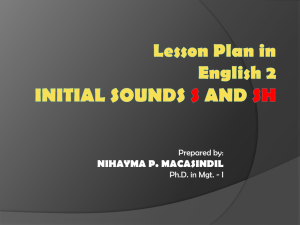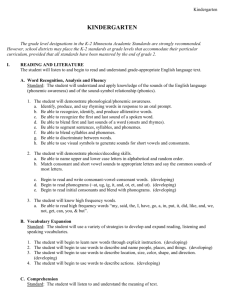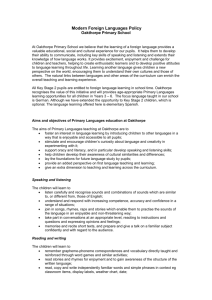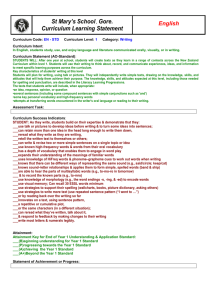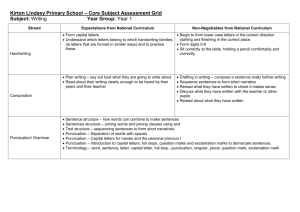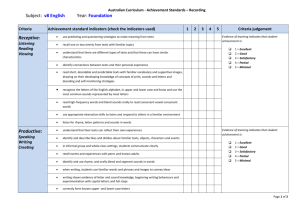The National Curriculum - Great Wood Primary School
advertisement
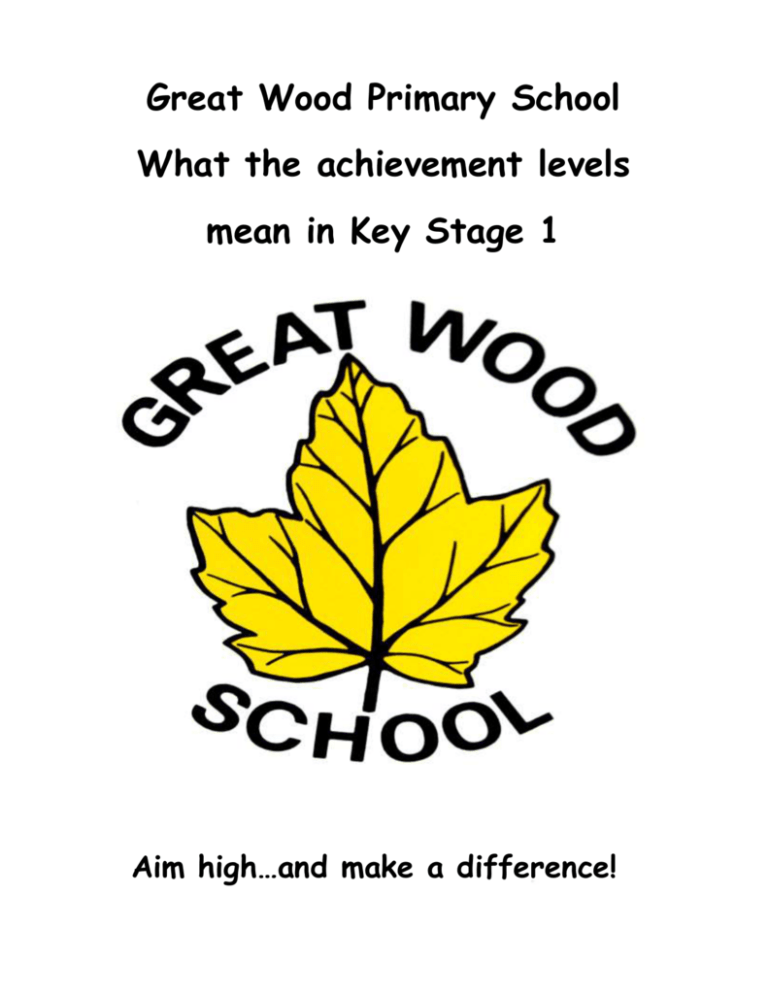
Great Wood Primary School What the achievement levels mean in Key Stage 1 Aim high…and make a difference! There are four 'Key Stages' during a child's school career. At the ages of 7, 11 and 16 students are tested. For each test or exam, the government has set different levels of attainment which are expected of children at each Key Stage. At Key Stages 1 and 2, children sit 'National Curriculum Tests' (often called SATs). At the end of their secondary school education, when they are aged 15 or 16, they sit their Key Stage 4 exams – GCSEs Key Stage Age School Year Groups Expected Levels of Study Key Stage 1 5-7 1-2 1-3 Key Stage 2 7-11 3-6 2-5 Key Stage 3 11-14 7-9 3-7 GCSE (Key Stage 4) 14-16 10-11 A*-G Children do not pass or fail National Curriculum Tests at Key Stages 1or 2. They are designed to help teachers measure pupils' progress; how much of the curriculum they understand now and what they might achieve in the future. The questions are written by education experts. At Key Stage 1 teachers mark the tests and use them to make judgments about the child’s levels. At Key stage 2 tests are sent off to be marked by teachers elsewhere in the country. Levels At Key Stages 1, 2, and 3, the National Curriculum is accompanied by a series of eight levels. These are used to measure your child's progress compared to pupils of the same age across the country. Each level is broken into 3 sublevels ‘a’, ‘b’ and ‘c’ with ‘a’ being highest. On average a child is expected to progress a sublevel every two terms. All schools assess pupils’ progress during the school year, though some make more frequent use of the National Curriculum levels than others. Parents receive information about the level their child has reached at parent-teacher evenings and in their school reports. Pupils are formally assessed at the end of Key Stages 1 and 2. At the end of Key Stage 1, the teacher’s assessment of a child’s progress will take account of their performance in several tasks and tests in English and maths. At the end of Key Stage 2, pupils must take national tests in English, maths and science. Parents are sent their test results and their teacher’s assessment of their progress. By the end of Key Stage 1, most children will have reached level 2, and by the end of Key Stage 2 most will be at level 4. At Great Wood, pupils in years 3, 4 and 5 take optional SATs. The results of these tests are used by teachers to determine the levels which are reported on the annual report card. These end of year tests help pupils, parents and teachers measure the progress pupils are making. The chart below outlines the levels expected at the end of each year. Great Wood pupils on average attain slightly above the national expectations leading to the slightly higher expectations. At the end of: Year One Year Two Year Three Year Four Year Five Year Six National Expectation 1a/2c 2b 2a/3c 3b 3a/4c 4b Great Wood Expectation 1a/2c 2b/2a 2a/3c 3b/3a 4c 4a What do the levels actually mean? Descriptions of skills have been written for each level in reading and writing. These descriptions help pupils and parents understand what the levels mean and what the steps to reach the next level. Teachers use the level descriptors through the year as part of their assessments. In end of year tests the level awarded is based on the number of right answers and the qualities in writing being converted into a level. There are no equivalent level descriptions for numeracy; expected learning objectives for each year group are listed. Early Learning Goals for Writing I can hear and say the first and last sounds in words and the vowel sound in the middle. I can match sounds and letters and sound the letters of the alphabet. I can use my sounds to write simple words and try more difficult words. I can change my writing to suit different jobs such as lists, stories and instructions. I can write my own name. I can write labels and captions and simple sentences, sometimes using capital letters and full stops. I can use a pencil properly to write recognisable letters. Writing Level 1c I can use full stops at the end of a sentence. I can sometimes use other punctuation marks. I can write recognisable letters, words and symbols that a reader can understand. I can write simple words and phrases. I can use words to say what I mean. I can sometimes help my teacher read and understand my writing. Writing Level 1b I can understand how full stops are used in writing and use them often at the end of my writing. I can use capital letters at the beginning of my writing. I can use simple words and phrases to write what I mean. I can decide which order to write my words. I can join two ideas together with ‘and’. I can use ideas from stories in my writing. I can talk to my friends and teacher about ideas for my writing. Writing Level 1a I can write phrases and simple statements. I use full stops and capital letters. I can use a simple structure in my writing. I can write clearly so that people can read my writing. I can write a story with a beginning and one event. I can choose the best words to write down my ideas. I can try to put all my ideas into my writing. Writing Level 2c I can use capital letters and full stops in some of my sentences I am beginning to use other punctuation, like question marks and exclamation marks I can link my ideas with ‘and’ and ‘then’ I will try to make sure that my writing has more than one idea I try to say at least two things about each idea I can re-tell my stories in order I can write stories that people can understand I am beginning to use story language in my writing e.g. once upon a time; one fine day I use some interesting words in my stories I think hard about the right words to use in my stories I can spell some easy words e.g. back, came, down, from, have, one I can use my letter sounds to spell difficult words I can think about other words that sound like the word I want to spell Writing Level 2b I can think of more interesting ways to join sentences than always using ‘and’ e.g. but, when I begin my sentences in different ways I can try to use full stops and capital letters at the beginning and end of every sentence I will make sure that my stories make sense all the way through I can write stories with a beginning, middle and ending I can write a story where several things happen I can think about whether somebody reading my writing would find it interesting I always try to use some interesting words I have never used before I know who my writing is for and make sure they will like my writing I can spell correctly my own easy words that I use a lot I can use letter patterns to help me spell words e.g. patterns like ‘oo’, ‘ck’, ‘nt’ I can use rhymes to help me spell words e.g. call, ball, fall, tall Writing Level 2a I can write in sentences I join my sentences in different ways e.g. He ran whilst I waited. I can start sentences in different ways: Although he was tired….Before he… I make sure that I use full stops and capital letters correctly I can use commas correctly I can write stories with a beginning, a middle and an ending I know the difference between stories and other writing In non-fiction writing I can link my ideas clearly I can think about whether the reader will understand and enjoy my writing when I write something I can write a story for other people e.g. Year 1 children I can use interesting describing words e.g. an enormous, black cloud I can use story language in my writing e.g. ‘Many years ago,’ ‘Once upon a time’ I can use more description in my stories, particularly of people and places I can think about the different styles I need for different kinds of writing I can spell many words correctly Writing Level 3c My sentences are written in the right tense and are easy to understand I can use other connectives instead of ‘and’ e.g. when, but, so, because I can punctuate all my sentences with a capital letter and full stop I can use question marks and exclamation marks I am starting to punctuate speech in my writing I can write a story with a simple story structure – an opening, characters and events I can try to write interesting endings to my stories I put two or more events in my stories to develop the story structure I make sure parts of my story follow one another in a sensible order I can describe the characters in my stories I use story language which I have seen in the books I have read I can use words to describe my setting e.g. gloomy cave, golden beach I can find and use new and interesting words in my writing I can spell many words correctly which have more than one syllable Reading Early Learning Goals I can match sounds to letters, naming and sounding the letters of the alphabet I can hear and say sounds in words in the order in which they occur I can read a range of familiar words and simple sentences independently I know that print carries meaning and is read from left to right, top to bottom I can learn more words by exploring the meaning and sounds of new words I can talk about the characters of a story, the opening, the setting and what its about I can talk about how information can be found in non-fiction texts I can retell a pattern story in order using the repeating language I can listen to stories and talk about them Reading Level 1c I know the difference between a word, a letter and a space. I can look at the pictures to help me understand the words. I can point to and hear each separate word. I can read CVC words like cat, dog, pig, pot, sat . . . I can use my letter sounds to read new words. I can read words from List 1 I can listen to a story all the way through. I can say how I feel about stories and poems. I can retell the main points in a recount in the right order. I can use the main points in a story to help me retell or act it out. I can talk about what is good and bad about the characters and events in stories. I can guess what is going to happen in a story that has repeated patterns. I can use the patterns and structures when I’m retelling a story. I can understand and use book words: book; cover; beginning; end; page; word; letter; line. I can re-read and enjoy my favourite books, songs and rhymes. Reading Level 1b I can read words from my teacher’s List 1. I can read familiar words in my books. I can blend phonemes to read words like play and push. I can blend phonemes to read words I have not seen before. I expect my reading books to make sense. I can talk about the main events in my texts. I can answer questions about events and ideas in my texts. I can guess what might be happening in my books with help from my teacher. I can guess what might happen to the characters in my books. I can tell the difference between fiction and non-fiction texts. I can name bold, italic and capital print. I can choose my favourite book and talk about it. Reading Level 1a I can read words from my teacher’s List 1. I can blend phonemes in words like string and catch in my reading. I can read new words by knowing what would fit or sound right in the sentence. I can talk about the main event in a story. I can find information in a text. I can say what I think about a character in a story. I can say who is bad and who is good. I can say what I think about the events in a story. I can tell the difference between fiction and non-fiction. I can find information in a non-fiction text, using the layout to help me. I can understand the order that events happen in a story. I can choose my favourite book from a selection and talk about it. Reading Level 2c I can use different ways to work out words I don’t know e.g. my phonics, reading on……. I can blend phonemes in words like train and read in my reading. I can blend sounds in words with consonants e.g. cry, brown, scratch I can find and talk about the main events in a story. I can find the answers to simple questions in my text. I can guess what might happen in a story by what has already happened. I can compare settings and events to my own experience. I can compare stories and say why they are similar and different. I can show that I understand the way information texts are organised and use this to help me when reading. I can describe the main plot in a story I can choose my favourite book from a selection and talk about it. Reading Level 2b I can use punctuation to help me make my reading more interesting. I can read words from my teacher’s List 2. I can split words into syllables to read long words. I can blend words with long vowel phonemes such as played, sound, moon. I use different ways to work out words I don’t know I often spot my own mistakes in reading and make changes I can guess what might happen in a text by comparing the plot to others I have read by the same author. I can guess what might happen in a text by comparing the plot to similar stories. I can think of questions about a topic and find the information in my books. I can predict the content of information texts and explanations. I can find clues in a text to help me explain the meaning. I can say what I think, and find parts of the text to say why I think it I can talk about what characters might be thinking or feeling using clues in the text. I can choose the right sort of book to help me find the information I need. I can choose or reject information in books by deciding how useful it is. I can use the alphabet to help me find information in alphabetically ordered texts. I can talk about the structure of a story. I can talk about how the words that the author has chosen affect the meaning. I can make reading choices based on what I have read before. Reading Level 2a I can read words with prefixes and suffixes and know what they mean in a text. I can read out loud using punctuation to help the listener understand. I can read fluently, using different voices and tones to give expression. I can retell a story and use details to make it clear. I can find information in a text and discuss it by referring to the text. I can talk about the theme of a story. I can discuss the reasons for events in a story. I can understand how certain words and phrases make texts funny, spooky or create moods. I can compare the layout, characters, settings and themes of different books. I can predict what a book might be about by skim reading, the title, contents and illustrations. I can find and talk about the vocabulary and writer’s knowledge the author has used. I can make reading choices based on what I have read before. Reading Level 3c I can read on my own and use different ways to work out the meaning. I can understand the job of different punctuation marks and use them to help with tone and expression. I can read all of the consonant digraphs in words. e.g. know, write, photo I can understand and refer to the main points in a text. I can tell the main differences between fiction and non-fiction texts. I can find information in a text and make notes and quotations. I can explore the themes and ideas in texts and find references to support my views. I can make sensible predictions based on knowledge of the text. I can discuss the actions of the main characters and justify my views by referring to the text. I can summarise the main points from a text. I can identify the main features of different genres and text-types. I can understand the function of a paragraph. � I can identify the words and phrases that an author has chosen to create mood and build tension. Reception Numeracy Objectives I can count to 20. I can count 10 objects. I can find numbers 0 to10. I can read / write 0 to 10. I can say which number is more or less; is greater or smaller. I can add two groups together and explain what I am doing. I can subtract one group from another and explain what I am doing. I can find one more than (and one less than) a number from 1 to 10. I can talk about, recognise and recreate a three colour pattern. I can make up and solve number stories. I can talk about solid shapes. I can recognise and name a circle, triangle, square, rectangle, sphere, cube and a cuboid. I can talk about the position of objects. I can say which object is longer or shorter; heavier or lighter. I can talk about flat shapes. Year 1 Numeracy Objectives I can count on or back in tens between 0 and 100. I can read and write numbers from 0 to at least 20. I can count on or back in ones from any small number. I can count at least 20 objects. I can say which number is less/more out of two numbers. I can say which is first, second, third, fourth and fifth. I can put numbers in order from 0 to at least 20. I can say which numbers come in between two numbers. I can say which number is 1 or 10 more than / less than a number up to 30. I can add more than 2 numbers together. I can use a number line to add by counting on. I know all the partners of numbers that add to make 10 by heart. I can find the difference between 2 numbers. I can say how many more I need to make a number. I can find the answer to number problems in my head and explain how I found the answer. I can compare 2 objects and say which is longer and which is shorter. I can say what equipment I will need to measure the length, mass, or capacity of something. I can estimate the length of something and then measure its length. I can compare 2 objects and say which is heavier and which is lighter. I can estimate the mass of something and then measure its mass. I can compare 2 objects and say which holds more and which holds less. I can estimate the capacity of something and then measure its capacity. I can name all the 2-D shapes and say how many sides and corners they have. I can name all the 3-D shapes and say how many faces, edges and corners they have and what shape the faces are. Year 2 Numeracy Objectives I can count up to 100 objects by grouping them. I can count on or back in ones or tens from any two-digit number. I can read and write numbers from 0 to at least 100. I can continue number sequences and explain the rule. I can say which two-digit numbers are odd or even. I can put numbers in order form 0 to at least 100. I can say the value of each digit in a two-digit number. I know my doubles up to 15 + 15. I can give the repeated addition and draw an array for a multiplication. I can say half of any number up to 30. I know my 2, 5 and 10 times-table by heart. I can say all the additions and subtractions that can be made with 2 numbers. I know by heart all the answers to any addition or subtraction up to 10. I can add numbers in my head in a different order to make the sum easier. I can choose the operation I need to find the answer to a number problem. I can use a strategy I have learned to find the answer and explain how I found the answer. I can estimate the length of something in centimetres and measure its length in centimetres. I can say which is the longest and shortest length out of a number of measurements. I can say what equipment I will need and what units I will be using, to measure the length, mass, or capacity of something. I can measure with a ruler, reading the length to the nearest centimetre. I can measure with a metre stick, reading the length to the nearest 10 centimetres. I can draw an accurate line of any length using a ruler. I can estimate the mass of something in grams and measure its mass in grams. I can say which is the heaviest mass out of a number of measurements. I can estimate the capacity of something in litres and measure its capacity in litres. I can say which is the biggest and smallest capacity out of a range of measurements. I can measure the capacity of liquid with a jug, reading the capacity to, the nearest 100 millilitres. I can name all the 2-D and 3-D shapes and describe them. I can sort shapes into groups. I can draw lines of symmetry. I can turn a shape through half turns and quarter turns and draw what it looks like in its new position. I know which way is clockwise, anti-clockwise, left and right. I can find right angles. I can give instructions for moving a robot through a simple maze. Spelling List 1 a all am and are at away big can cat come dad day dog for get go going he I in is it like look me mum my no of on play said see she the they this to up was we went yes you Spelling List 2 about after again an another as back ball be because bed been boy brother but by call(ed) came can't could did do don't dig door down first from girl good got had half has have help her here him his home house how if jump just last laugh little live(d) love made make man many may more much must name new next night not now off old once one or our out over people push pull put ran saw school seen should sister so some take than that their them then there these three time too took tree two us very want water way were what when where who will with would your Plus: days of the week months of the year numbers to twenty common colour words pupil's name and address name and address of school
